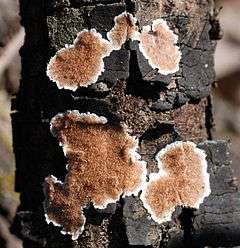Steccherinum
| Steccherinum | |
|---|---|
 | |
| Steccherinum ochraceum | |
| Scientific classification | |
| Kingdom: | Fungi |
| Division: | Basidiomycota |
| Class: | Agaricomycetes |
| Order: | Polyporales |
| Family: | Steccherinaceae |
| Genus: | Steccherinum Gray (1821) |
| Type species | |
| Steccherinum ochraceum (Pers.) Gray (1821) | |
| Synonyms[1] | |
Steccherinum is a widely distributed genus of hydnoid crust fungi in the family Steccherinaceae.[2]
Taxonomy
Steccherinum was circumscribed by Samuel Frederick Gray in his 1821 work A Natural Arrangement of British Plants.[3]
Description
Steccherinum fungi have a range of fruit body morphologies, including resupinate (crust-like), effused-reflexed (crust-like with the edges extending outwards to form caps), or pileate with either a stipe or only a stipe-like base.
Species
A 2008 estimate placed 33 species in Steccherinum.[4]
- S. agaricoides (Sw.) Banker (1906)
- S. aggregatum Hjortstam & Spooner (1990) – Sabah
- S. alaskense Lindsey & Gilb. (1980)[5]
- S. albidum Legon & P.Roberts (2002)[6] – Great Britain
- S. albofibrillosum (Hjortstam & Ryvarden) Hallenb. & Hjortstam (1988)
- S. basibadium Banker (1912)
- S. bourdotii Saliba & A.David (1988)[7] – Europe
- S. ciliolatum (Berk. & M.A.Curtis) Gilb. & Budington (1970) – Portugal
- S. confragosum Maas Geest. & Lanq. (1975)[8] – Brunei
- S. crassiusculum K.A.Harrison (1964)[9]
- S. cremeoalbum Hjortstam (1984)
- S. cremicolor H.S.Yuan & Sheng H.Wu (2012)[10] – Taiwan
- S. diversum Hjortstam & Melo (1999) – Roraima
- S. elongatum H.S.Yuan & Sheng H.Wu (2012)[10] – Taiwan
- S. ethiopicum Maas Geest. (1974)[11]
- S. fimbriatum (Pers.) J.Erikss. (1958) – Europe
_J._Erikss_201034.jpg)
Steccherinum fimbriatum on Quercus cerris
- S. galeritum Maas Geest. (1974)[11]
- S. gilvum Maas Geest. (1974)[11]
- S. gracile (Pilát) Parmasto (1968)
- S. helvolum (Zipp. ex Lév.) S.Ito (1955)
- S. hydneum Rick ex Maas Geest. (1974)[11]
- S. labeosum Maas Geest. & Lanq. (1975)[8] – Kenya
- S. lacerum (P.Karst.) Kotir. & Saaren. (2009)
- S. laeticolor (Berk. & M.A.Curtis) Banker (1912) – Latvia; South Carolina
- S. lanestre Maas Geest. (1974)[11]
- S. lusitanicum (Bres.) Ryvarden (1981)
- S. meridiochraceum Saliba & A.David (1988)
- S. minutissimum Snell & E.A.Dick (1958)
- S. ochraceum (Pers.) Gray (1821)
- S. oreophilum Lindsey & Gilb. (1977) – Europe
- S. peckii Banker (1912)
- S. perparvulum Hjortstam & Ryvarden (2008)
- S. peruvianum Maas Geest. (1978)
- S. plumarium (Berk. & M.A.Curtis) Banker (1906)
- S. pseudochraceum Saliba & A.David (1988)
- S. rawakense (Pers.) Banker (1912) – China
- S. reniforme (Berk. & M.A.Curtis) Banker (1906) – South America
- S. resupinatum G.Cunn. (1958)[12] – New Zealand
- S. robustius (J.Erikss. & S.Lundell) J.Erikss. (1958)
- S. russum Maas Geest. & Lanq. (1975)[8] – Africa
- S. scalare Maas Geest. & Lanq. (1975)[8] – Africa
- S. scruposum Maas Geest. & Lanq. (1975)[8] – Africa
- S. straminellum (Bres.) Melo (1995)
- S. subcrinale (Peck) Ryvarden (1978)
- S. subglobosum H.S.Yuan & Y.C.Dai (2005)[13] – China
- S. subulatum H.S.Yuan & Y.C.Dai (2005)[13] – China
- S. tenue Burds. & Nakasone (1981)
- S. tenuispinum Spirin, Zmitr. & Malysheva (2007)[14]
- S. willisii Maas Geest. (1974)[11]
- S. zeylanicum Maas Geest. (1974)[11]
References
- ↑ "Steccherinum Gray 1821". MycoBank. International Mycological Association. Retrieved 2011-02-16.
- ↑ Miettinen, Otto; Larsson, Ellen; Sjökvist, Elisabet; Larsson, Karl-Henrik (2012). "Comprehensive taxon sampling reveals unaccounted diversity and morphological plasticity in a group of dimitic polypores (Polyporales, Basidiomycota)" (PDF). Cladistics. 28: 251–270.
- ↑ Gray, Samuel F. (1821). A Natural Arrangement of British Plants. London, UK: Baldwin, Cradock, and Joy. p. 651.
- ↑ Kirk PM, Cannon PF, Minter DW, Stalpers JA (2008). Dictionary of the Fungi (10th ed.). Wallingford, UK: CAB International. p. 662. ISBN 978-0-85199-826-8.
- ↑ Lindsey, J.P.; Gilbertson, R.L. (1979). "A new Steccherinum (Aphyllophorales, Steccherinaceae) from Alaska". Mycologia. 71 (6): 1264–1266.
- ↑ Legon, N.W.; Roberts, P. (2002). "Steccherinum album: a new species from southern England". Czech Mycology. 54 (1-2): 7–9.
- ↑ Saliba, J.; David, A. (1988). "Apports des caractères culturaux et des confrontations dans l'étude des représentants européens du genre Steccherinum (Basidiomycètes, Aphyllophorales)". Cryptogamie Mycologie (in French). 9 (2): 93–110.
- 1 2 3 4 5 Maas Geesteranus, R.A.; Lanquetin, P. (1975). "Observations sur quelques champignons hydnoides de l'Afrique". Persoonia (in French). 8 (2): 145–165.
- ↑ Harrison, Keith A. (1964). "New or little known North American stipitate Hydnums". Canadian Journal of Botany. 42 (9): 1205–1233. doi:10.1139/b64-116.
- 1 2 Yuan, Hai-Sheng; Wu, Sheng-Hua (2012). "Two new species of Steccherinum (Basidiomycota, Polyporales) from Taiwan". Mycoscience. 53 (2): 133–138. doi:10.1007/s10267-011-0139-y.
- 1 2 3 4 5 6 7 Maas Geesteranus, R.A. (1974). "Studies in the genera Irpex and Steccherinum". Persoonia. 7 (4): 443–581.
- ↑ Cunningham, G.H. (1958). "Hydnaceae of New Zealand. I. - The pileate genera Beenakia, Dentinum, Hericium, Hydnum, Phellodon and Steccherinum". Transactions and Proceedings of the Royal Society of New Zealand. 85: 585–601.
- 1 2 Yuan, H.-S.; Dai, Y.-C. (2005). "Two new species of Steccherinum (Basidiomycota) from China". Mycotaxon. 93: 173–178.
- ↑ Spirin, W.; Zmitrovich, I.; Malysheva, V. (2007). "Steccherinum tenuispinum (Polyporales, Basidiomycota), a new species from Russia, and notes on three other species" (PDF). Annales Botanici Fennici. 44: 298–302.
External links
This article is issued from Wikipedia - version of the 10/21/2016. The text is available under the Creative Commons Attribution/Share Alike but additional terms may apply for the media files.